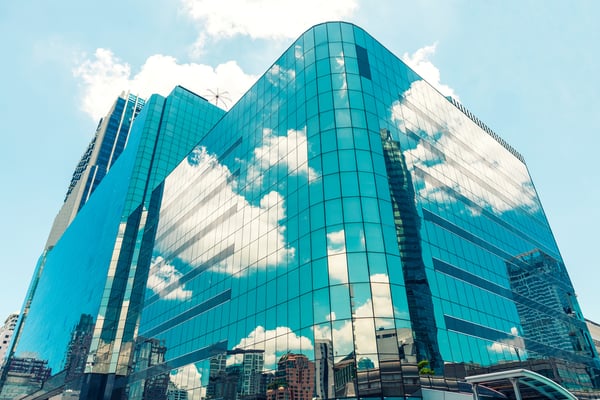Why Is Glass so Common in Commercial Buildings?

Glass is a versatile material, manufactured by applying intense heat to sand or quartz. It is used in multiple industries, including construction. Glass provides a sleek, clean, and modern aesthetic when used in building facades, giving architects a wide range of design possibilities.
The glass allows innovative designs, and it can be treated to improve insulation and energy efficiency. Large glass envelopes have become very common, especially in urban areas. However, there are many different types of glass, and selecting the right type for a project can pose a technical challenge.
Advantages of Using Glass as a Building Material
Glass is used extensively in commercial buildings, mainly due to its special features and advantages. This section summarizes some benefits of glass as a building material.
Aesthetics
- Glass can absorb, refract, or transmit light. It has the ability to make any building look more stunning and modern.
- Using glass in building facades and interiors enhances the ambiance. Interiors appear larger and more open, with abundant natural lighting.
- Glass walls help increase the floor area, providing more space for tenants.
Physical Properties
- Glass is an excellent electrical insulator.
- Malleable glass can be blown, drawn, and pressed to any shape. It is a versatile material with multiple applications, ranging from general glazing to furniture.
- Glass is resistant to abrasion.
- Glass is resistant to high temperatures. It can be used in fireplaces, cooking tops, and other high-temperature areas where low material expansion is needed.
Save Energy and Enhance Building Performance with an Optimized Envelope and MEP Design!
Positive Impact on Occupants
- Natural lighting has a positive psychological effect, improving the mood of occupants.
- Glass helps improve work efficiency and performance in offices and schools.
Weather Resistance
- Glass can transmit 80% of daylight in any direction without weathering, clouding or yellowing.
- Glass is resistant to the weather and rust, without compromising its appearance and integrity.
- The smooth surface of the glass makes it dustproof, allowing easier maintenance.
Sustainable and Energy Efficient
- Glass is recyclable, and can be reused many times without losing quality.
- Glass reduces the dead load of a building since it is lightweight.
- There are many energy-efficient glass products, and low-emissivity glass (Low-E) is one of the most widely used. This type of glass achieves energy savings and lower utility bills, as well as points under the LEED rating system.
Cost-Effective
- The glass allows natural lighting, reducing the artificial lighting output required during the daytime.
- Efficient glass provides energy savings, achieving synergy with efficient MEP systems. This combination can drastically lower your utility bills.
Technical Challenges in Glass Buildings

As a construction material, glass provides several benefits that make it popular in commercial projects, and even modern residential buildings. However, certain factors should be considered before starting construction.
Heat Transfer
Glass buildings allow natural lighting, but this causes solar heat gain and higher cooling expenses during summer. Thanks to innovation in glass manufacturing, this can be offset with energy efficient fenestration.
Glare
Another issue that must be considered is the potential glare that occurs with glass surfaces. There are special coatings and techniques to reduce glare in glass, and the window layout can also be optimized so the sun is not directly visible.
Benefits of Low-E Glass
Low-emissivity glass reduces heat transfer significantly, compared with conventional glass. This type of glass improves natural lighting and thermal performance in buildings. Low-E coatings block parts of the solar spectrum, and they limit the passage of ultraviolet and infrared light. However, visible light can pass through without any problem.
A low-emissivity material is one that radiates small amounts of thermal energy. When the glass in a building has this property, heat is conserved more effectively during winter, and heat gain is reduced during summer. As a result, the HVAC system can operate more efficiently.
Conclusion
Glass buildings offer a unique architecture that cannot be achieved with other materials. However, make sure your review all the pros, cons and technical requirements of glazing. With proper planning, architects and engineers can design a beautiful structure that is environmentally friendly and energy efficient. This benefits clients as well, since they can develop buildings that balance natural lighting and energy efficiency.

Michael Tobias
Michael Tobias, the Founding Principal of NY Engineers, currently leads a team of 50+ MEP/FP engineers and has led over 1,000 projects in the US
Join 15,000+ Fellow Architects and Contractors
Get expert engineering tips straight to your inbox. Subscribe to the NY Engineers Blog below.



